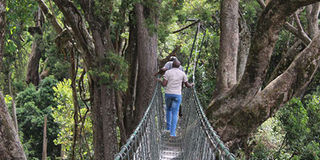Ngare Ndare Forest, the bird watchers’ paradise of Meru

Visitors on nature walk in Ngare Ndare Forest in Meru County. Those who have taken a walk in the forest talk of an experience so close to nature that it leaves them with refreshing feelings that linger for years. PHOTO | GITONGA MARETE | NATION MEDIA GROUP
What you need to know:
- Ngare Ndare — a Unesco world heritage site — draws visitors from Kenya and beyond.
- It can be approached from Timau on the Meru-Nanyuki road or Lewa on the Meru-Isiolo road.
- With one cow, a farmer around the forest is able to generate enough gas for cooking.
Those who have taken a walk in Ngare Ndare Forest in Meru County talk of an experience so close to nature that it leaves them with refreshing feelings that linger for years.
Nature lovers are spoilt for choice when they take a canopy walk about 40 feet high, watching wild animals beneath as they interact with indigenous trees emitting therapeutic scents.
Apart from elephant, buffalo, rhino, zebra and gazelle herds, the bird watchers’ paradise also hosts butterflies and monkeys.
WORLD HERITAGE SITE
The forest borders Lewa Conservancy and can be approached from Timau on the Meru-Nanyuki road or Lewa on the Meru-Isiolo road.
Ngare Ndare — a Unesco world heritage site — draws visitors from Kenya and beyond.
A local tourist is charged Sh2,000 while a foreign one has to part with Sh3,000 to enter the forest.
The forest has rivers with breath-taking waterfalls that form “blue rock pools” where visitors can cool off as they swim.
If lucky, one can witness the spectacle of elephants sliding down the slopes on their bottoms to the river to quench their thirst.
KAYAKING CONTESTS
“Teams come here for kayaking contests while the hills around are popular with rock climbers. British soldiers from Laikipia County love these activities,” Mr Dominic Maraga, a guide at the forest, says.
We met an artist working on paintings at the wildlife observation platform. She told us that the forest provides a most serene environment for her work.
“I come here for reflection and to paint nature. My work requires a lot of concentration and this is the ideal place,” the artist, who declined to be named, said.
Ngare Ndare Forest Trust manages the woodland together with 6,200 members of the community forest association (CFA).
EARNINGS
The association was established in 2004 and runs eco-tourism projects that earn locals about Sh8.5 million every year.
Mr Maraga, who is also the project manager, says the success story of the trust is told through community members who live within a five-kilometre radius of the 13,850-acre forest.
“We owe the success of this sanctuary to community members who have worked with us to conserve the ecosystem,” he said.
Members also organise tree planting in the forest and surrounding areas, with 14 nurseries supplying the seedlings. Last year they planted 35,000 seedlings in the forest and a similar number outside.
The group runs the one-for-one project where locals get the same number of seedlings they buy from the nurseries for free.
USER GROUPS
CFA members are divided into user groups -- herders, firewood and seed collectors, water extractors, herbalists, honey harvesters and youth -- who help the KWS-trained rangers to provide security.
“They carry out day and night patrols in collaboration with national police reservists,” Mr Maraga told the Nation.
“Recently we acquired a digital system that monitors activities in the forest. We’re able to track animal movements, the number of people entering the forest and any other activity. This has improved security. We are also using the system for research,” he added.
Mr Maraga also said that the system is being used to compile accurate information on the number of animals in the forest.
“We have also started a green energy scheme that incorporates installing biogas units and energy saving stoves. Our main aim is to buy solar units for members,” he said.
BIOGAS
With one cow, a farmer around the forest is able to generate enough gas for cooking.
“This means they do not have to entirely depend on firewood, thus conserving the environment in return,” he said.
The trust sources for funds from conservation agencies. The money is used to help members pay school fees for their children and establish tree nurseries.
According Mr Maraga, the forest has been gaining popularity as a tourist destination in the last four years, recording an average of 6,000 visitors annually.
“This is one of the most successful community managed forests in the country,” he said.
Is there a site you want us to feature? Write an email to [email protected]





